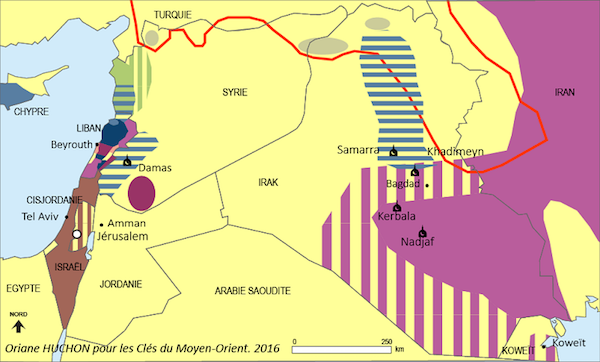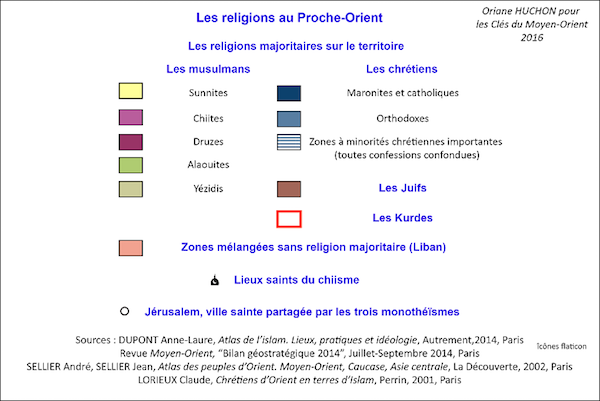CONFERENCES 1. Conference: “Islam ‒ Knowledge ‒ Power: Interactions from a Theological and Historical Perspective”, University of Fribourg, Switzerland, 22-13 February 2017 2. Section: “Islam”, AAR MidWest Region Conference, Ball State University, Muncie, IN, 3-4 March 2017 3. Conference: “History and Society on TV in the Middle East”, University of Maryland, College Park, 6-7 April 2017 4. Conference: “Dynamics of Global Inequality: New Thinking in Global Affairs”, Rutgers, State University of New Jersey, Newark, 21 April 2017 5. Workshop: “Muslim Secularities: Explorations into Concepts of Distinction and Practices of Differentiation”, Leipzig University, 18-20 June 2017 6. Conference: “Democratization and Constitutional Design in Divided Societies”, University of Cyprus, Nicosia, 24-27 June 2017 7. International Conference: "International Degree Programmes in Humanities and Cultural Studies: Chances, Perspectives, Challenges", University of Mainz, Germany, 29-30 June 2017 8. Conference: "Personalised Media and Participatory Culture (Focus on MENA Region)", London School of Economics, 29-30 June 2017 9. Panel: “Worldviews of Millennials: Education, Social Inclusion and Countering Violent Extremism”, 34th Conference of the International Society for the Sociology of Religion, Lausanne, Switzerland, 4-7 July 2017 10. 8th Gulf Research Meeting, University of Cambridge, UK, 1-4 August 2017 11. Workshop: “Gender and Identity in the Gulf: Cultural Constructions and Representations”, 2017 Gulf Research Meeting, University of Cambridge, UK, 1-4 August 2017 12. Panel: “Beyond Karbala: Theorizing Shiʿi Materiality”, German Association for the Study of Religion, Marburg, 13-16 September 2017 13. Conference: “Jewish Migrants from Hitler’s Europe in Asia, Africa, and Beyond “, German Historical Institute Washington DC, Kolkata, India, 15-17 February 2018 POSITIONS 14. 10 Early Career Fellowships at the Lichtenberg-Kolleg, University of Göttingen, Germany 15. Associate Professor of Islamic History, University of Oxford 16. Visiting Assistant Professor of Islamic Studies, Colgate University, Hamilton, New York 17. McGill Visiting Assistant Professor of International Studies (Focus on Middle East Studies), Trinity College, Hartford, Connecticut 18. Post-Doctoral Fellowship in Iranian Studies, MacMillan Center, Yale University 19. Assistant or Associate Professor in International Relations, American University in Cairo OTHER INFORMATION 20. Turkish Foreign Policy Winter School, Wise Men Center for Strategic Studies (BILGESAM), 15-19 March 2017, Istanbul 21. Andrew Rippin Best Paper Prize, International Qur’anic Studies Association 22. Articles for the Canadian Journal for Middle East Studies 23. Articles on "The Massacres of 1894-1896 in the Ottoman Empire: Genesis, Consequences and Continuities of Extreme Violence" for Journal "Études Arméniennes Contemporaines" ___________ If you want to distribute an announcement via DAVO-Info-Service (about 1500 recipients) and EURAMES Info Service (more than 6000 recipients, only English and French announcements), please apply the usual format of the text with no more than 50 words and no attachment. Please send only the most important information to mailto:davo@geo.uni-mainz.de and refer to further details with a link to the respective website or an email address. Best regards, Guenter Meyer, Center for Research on the Arab World (CERAW), University of Mainz ____________________ CONFERENCES 1. Conference: “Islam ‒ Knowledge ‒ Power: Interactions from a Theological and Historical Perspective”, University of Fribourg, 22-13 February 2017 The conference is organized by the Swiss Centre for Islam and Society, University of Fribourg and the Post Graduate Program Islamic Theology, Germany. Deadline for registration: 14 February 2017. Information: www.unifr.ch/webnews/content/159/file/A6-5_Tagung_IKP%281%29.pdf _____________ 2. Section: “Islam”, AAR MidWest Region Conference, Ball State University, Muncie, IN, 3-4 March 2017 Solicits proposals for papers and panels focusing on any aspect of the Islamic tradition, including its texts, history, or practices. Proposals may focus on any time period and be from any disciplinary approach, so long as the topic is capable of engaging scholars of Islam. Deadline for abstracts: 10 January 2017. Information: https://sites.google.com/site/aarmidwestregion/call-for-papers _____________ 3. Conference: “History and Society on TV in the Middle East”, University of Maryland, College Park, 6-7 April 2017 This multidisciplinary conference will explore the transnational dimensions of Middle Eastern television productions and the debates they have prompted over national identities, history, gender relations, and cultural taboos. Organizer: Professor Madeline Zilfi. Information: https://history.umd.edu/events/history-and-society-tv-middle-east-conference _____________ 4. Conference: “Dynamics of Global Inequality: New Thinking in Global Affairs”, Rutgers, State University of New Jersey, Newark, 21 April 2017 This graduate student conference seeks to create an interdisciplinary conversation, and we welcome participants from multiple disciplines, including, but not limited to: Political Science and International Relations, Sociology, Anthropology, Geography, Critical Ethnic Studies, American Studies, African and African American Studies, History and the Humanities. Deadline for abstracts: 27 January 2017. Information: http://dga.rutgers.edu/posts/2017-global-affairs-conference _____________ 5. Workshop: “Muslim Secularities: Explorations into Concepts of Distinction and Practices of Differentiation”, Leipzig University, 18-20 June 2017 We call for papers delineating concepts and practices of distinction and differentiation within Islamicate social and historical contexts, the conditions of their emergence, and the socio-economic, doctrinal, and political conflicts that have sustained them. We will cover travel and accommodation for the selected participants. Deadline for abstracts: 1 March 2017. Information: http://www.multiple-secularities.de/application/calls/call-for-papers/ _____________ 6. Conference: “Democratization and Constitutional Design in Divided Societies”, University of Cyprus, Nicosia, 24-27 June 2017 The conference will provide an opportunity to examine the role of different factors in fostering democratization in the context of regional and global integration. We welcome contributions that focus on democratization as an open-ended process driven by either internal or external factors, embedded in local, regional, or global dynamics as well as social, economic and legal legacies of the past. Deadline for abstracts: 31 January 2017. Information: http://www.ipsa.org/news/call-for-paper/ipsa-joint-conference-rc14-rc28-rc13-democratization-and-constitutional-design-d _____________ 7. International Conference: "International Degree Programs in Humanities and Cultural Studies: Chances, Perspectives, Challenges", University of Mainz, Germany, 29-30 June 2017 We are looking forward to participants from the following fields: - international programs, - innovative study projects, - employers of alumni of humanities and cultural studies, - national and international education agencies. Deadline for abstracts: 28 February 2016. Information: www.blogs.uni-mainz.de/fb05-talcme-eng/multiplier-event-mainz/ _____________ 8. Conference: "Personalized Media and Participatory Culture (Focus on MENA Region)", London School of Economics, 29-30 June 2017 This conference aims at problematizing the assumed connections between particular parts of the world, networks (both digital and real-world), participatory cultures, young people, and emerging media tools. Deadline for abstracts: 31 January 2017. Information: www.lse.ac.uk/middleEastCentre/research/Collaboration-Projects/collaborations%202015-2016/AUS/Conference.aspx _____________ 9. Panel: “Worldviews of Millennials: Education, Social Inclusion and Countering Violent Extremism”, 34th Conference of the International Society for the Sociology of Religion, Lausanne, Switzerland, 4-7 July 2017 This panel will examine the nexus between worldviews education and countering extremism; and how young people’s worldviews may inform the development of educational responses to enhance social inclusion, particularly in religiously diverse societies. It also encourages discussion of intersectional perspectives on diverse worldviews education and race, gender and sexuality. Deadline for abstracts: 10 January 2017. Information: https://wp.unil.ch/issr2017conference _____________ 10. 8th Gulf Research Meeting, University of Cambridge, UK, 1-4 August 2017 The objective of the Gulf Research Meeting is to provide an academic environment to foster Gulf studies and to encourage scholarly and academic exchange among those working on or interested in the developments taking place that are defining the Gulf region and their constituent societies. The conference will be hosting 11 workshops. Deadline for application: 31 January 2017. Information: http://gulfresearchmeeting.net/index.php _____________ 11. Workshop: “Gender and Identity in the Gulf: Cultural Constructions and Representations”, 2017 Gulf Research Meeting, University of Cambridge, UK, 1-4 August 2017 We are seeking papers on research around museums and heritage, artistic practices, identity and representation, literary studies, education, art historical theory and visual anthropology. Papers must focus on the Gulf region and will explore new perspectives on how gender, identity, and representation are manifested locally, nationally, regionally and/or internationally. Deadline for abstracts: 31 January 2017. Information: www.gulfresearchmeeting.net/workshop/131_WS9%20-%20Gender%20and%20Identity%20in%20the%20Gulf.%20Cultural%20Constructions%20and%20Representations.pdf _____________ 12. Panel: “Beyond Karbala: Theorizing Shiʿi Materiality”, German Association for the Study of Religion, Marburg, 13-16 September 2017 This panel invites to think about how theoretical assumptions and academic approaches towards Shiʿi materiality can be made fruitful to contribute to a broader understanding of Shiʿism, and account for non-binary views. While doing so the panel tries to assess Iranian and non-Iranian forms of Shiʿi materiality alike. Deadline for abstracts: 22 January 2017. Information: Christian Funke (christian.funke@ithrw.uni-hannover.de) and Robert Langer (robert.langer@uni-bayreuth.de). _____________ 13. Conference: “Jewish Migrants from Hitler’s Europe in Asia, Africa, and Beyond “, German Historical Institute Washington DC, Kolkata, India, 15-17 February 2018 During this conference we would like to pay special attention to neglected temporal and spatial aspects of forced migration from Nazi Germany and occupied Europe. We will focus on the destinations and processes of migration, giving particular attention to colonial and semi-colonial settings and the transit phase of migration. Deadline for abstracts: 28 February 2017. Information: www.ghi-dc.org/events-conferences/event-history/2018/conferences/in-global-transit-jewish-migrants-from-hitlers-europe-in-asia-africa-and-beyond.html?L=0 _____________ POSITIONS 14. 10 Early Career Fellowships at the Lichtenberg-Kolleg, University of Göttingen, Germany For the period October 2017 to July 2019 we invite early career scholars to join one of the research groups on: - Globalising the Enlightenment: Knowledge, Culture, Travel, Exchange and Collections, or: - Human Rights, Constitutional Politics and Religious Diversity, or: - Moritz Stern Fellowships in Modern Jewish Studies: Cultural, Intellectual and Literary History Deadline for application: 12 February 2016. Information: www.uni-goettingen.de/de/early-career-fellowships-2017-19/501529.html _____________ 15. Associate Professor of Islamic History, University of Oxford The successful candidate will have an outstanding record of publication and research. With a record of successful undergraduate teaching and the ability to lecture to a mixed audience, you will demonstrate a high degree of expertise in the Arabic language and the ability to instruct students in the use primary sources in Arabic. Candidates must have a doctorate in the field of Islamic History. Deadline for application: 10 February 2017. Information: www.ox.ac.uk/about/jobs/academic/index/ac22979j/ _____________ 16. Visiting Assistant Professor of Islamic Studies, Colgate University, Hamilton, New York Candidates with expertise in Islam in any period or region are encouraged to apply, although the Classical Period is preferred. Knowledge of relevant languages is required. Familiarity with the discipline of Religious Studies is desirable, as is knowledge of the social, political, and historical study of Islamic civilizations. Completion of Ph.D. is expected prior to or shortly after the date of hire. Deadline for application: 30 January 2017. Information: https://academicjobsonline.org/ajo/jobs/8720 _____________ 17. McGill Visiting Assistant Professor of International Studies (Focus on Middle East Studies), Trinity College, Hartford, Connecticut This fellowship is a one-year appointment for a recent Ph.D. (within the past five years) who has either received a bachelor’s degree from a non-North American university or else has lived for a substantial period outside the United States. Deadline for application: 1 February 2017. Information: https://trincoll.peopleadmin.com/postings/1229 _____________ 18. Post-Doctoral Fellowship in Iranian Studies, MacMillan Center, Yale University The Yale Program in Iranian Studies accepts applications for the newly-established Ehsan Yarshater Fellowship in Iranian and Persian studies for 2017-18 (renewable for one year). Applicants in all fields of humanities and social and political sciences who have recently received their PhDs or are in the early stages of their academic career may apply. Deadline for application: 15 January 2017. Information: http://macmillan.yale.edu/sites/default/files/files/2017-18_IranianStudies_POSTDOC_Final_Dec2016.pdf _____________ 19. Assistant or Associate Professor in International Relations, American University in Cairo The Department of Political Science invites applications for a fixed term 1 year contract position. PhD is required at time of appointment. Successful candidates should have an ongoing program of research and publication. Teaching experience is preferred. Position is open until filled. Apply online at: http://www.click2apply.net/hbwbspmbw9 _____________ OTHER INFORMATION 20. Turkish Foreign Policy Winter School, Wise Men Center for Strategic Studies (BILGESAM), 15-19 March 2017, Istanbul The Winter School will include all aspects of Turkish Foreign Policy, main actors of policy-making processes, institutes and Turkey’s relations with regional and global powers. Regional security topics such as Turkey’s role on the Middle Eastern security, Black Sea security, security of the South Caucasia, are also in the agenda. Deadline for registration: 3 March 2017. Information: www.bilgesam.org/en/incele/2544/-foreign-policy-winter-school--15-19-march-2017/#.WF40PWczWJC _____________ 21. Andrew Rippin Best Paper Prize, International Qur’anic Studies Association In honor of Andrew Rippin, the IQSA will award a prize to the best paper delivered at the 2016 Annual Meeting in San Antonio by a graduate student or early career scholar. The prize winner will receive $250 and an expanded and edited version of the paper will qualify for publication in the Journal of the International Qur’anic Studies Association 2 (2017). Deadline for abstracts: 5 January 2017. Information: https://iqsaweb.wordpress.com/2016/12/19/andrew-rippin-best-paper-prize/ _____________ 22. Articles for the Canadian Journal for Middle East Studies The Canadian Journal for Middle East Studies, CJMES is a print and online academic journal published by Institute for Middle East Studies, Canada. We are interested in articles that focus on the Middle East in a wide range of contexts, and encourage articles from humanities and social science perspectives. Deadline for articles: 30 March 2017. Information: www.imesc.org/index.php?cmd=view_event&id=13 _____________ 23. Articles on "The Massacres of 1894-1896 in the Ottoman Empire: Genesis, Consequences and Continuities of Extreme Violence" for Journal "Études Arméniennes Contemporaines" Articles are invited in English or French. Deadline for abstracts: 30 January 2017. Information: https://networks.h-net.org/node/73374/announcements/157418/cfp-massacres-1894-1896-ottoman-empire-genesis-consequences-and
dimanche 25 décembre 2016
EURAMES Info Service 50/2016
vendredi 23 décembre 2016
θρησκείες στην Εγγύς Ανατολή. α', β', γ' και δ' μέρος
CARTOGRAPHIE DES RELIGIONS (1) – APERÇU RÉGIONAL AU XXIE SIÈCLE
ARTICLE PUBLIÉ LE 02/12/2016
Par Oriane Huchon
Dernières actualités
- L’acheminement des hydrocarbures du Moyen-Orient. Première partie : le gazoduc Qatar-Turquie et le « Islamic Pipeline » - 23/12/16
- De nouvelles salles accessibles au public au musée national de Beyrouth - 16/12/16
- Comment l’histoire explique l’actualité d’Alep. Partie 3. La destruction du patrimoine culturel de la ville et des monuments dans le conflit en Syrie depuis 2011 : zone ouest et zone est, un patrimoine contrasté - 17/11/16
Plusieurs articles sur les différents courants de l’islam sont déjà parus sur Les clés du Moyen-Orient. Celui-ci a pour objectif de présenter une cartographie de l’implantation des religions au Moyen-Orient et en Afrique du Nord. Les courants principaux y sont représentés, ainsi que les principaux lieux saints (sunnites et chiites), les lieux de naissance des principaux ordres soufis, et les minorités religieuses.
Le Moyen-Orient et l’Afrique du Nord sont les terres d’expansion de l’islam aux VIIe et VIIIe siècles de notre ère. Il ne faudrait pourtant pas considérer ces vastes territoires comme un monde unifié religieusement. Les religions antérieures à l’islam, le christianisme sous ses diverses formes (maronite, orthodoxe, copte, catholique…) et le judaïsme, demeurent au sud et à l’est de la Méditerranée et disposent d’un statut spécial dans le droit musulman, le statut de dhimmi. Jusqu’à la chute de l’Empire ottoman, le statut de dhimmi était communément appliqué dans les diverses communautés musulmanes.
Les musulmans sont de nos jours environ un milliard et demi sur la planète, soit 23% de la population mondiale. Ils forment le groupe religieux le plus important au monde après le christianisme. Les sunnites (toutes écoles confondues), représentent 87,4% de la population musulmane ; les chiites duodécimains 8,4 %, les autres mouvances chiites 3,5% et les ibadites 0,7% (1). La majorité de ces musulmans se trouve désormais en Asie, avec entre 700 et 800 millions de pratiquants, principalement en Indonésie (premier pays musulman du monde), en Afghanistan, en Inde, au Pakistan, au Bangladesh et en Chine (2). Au Moyen-Orient (Turquie, Egypte et Iran compris), ils seraient entre 350 et 400 millions ; alors qu’au Maghreb ils seraient un peu moins de 90 millions.
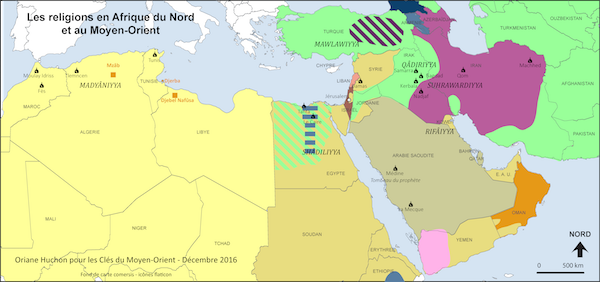
A titre comparatif, les chrétiens représentent 32% de la population mondiale et sont 2,2 milliards sur Terre. Les hindous sont 1 milliard, les bouddhistes 500 millions et les juifs 14 millions (4). Les juifs ont globalement fui les terres d’islam depuis la création d’Israël, et 25 % de la population juive globale vit actuellement en Israël. Les chrétiens d’Orient sont entre 10 et 16 millions au début du XXIe siècle (5).
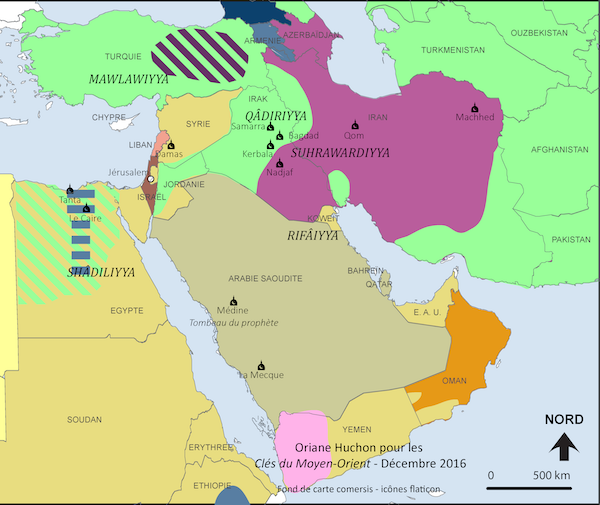
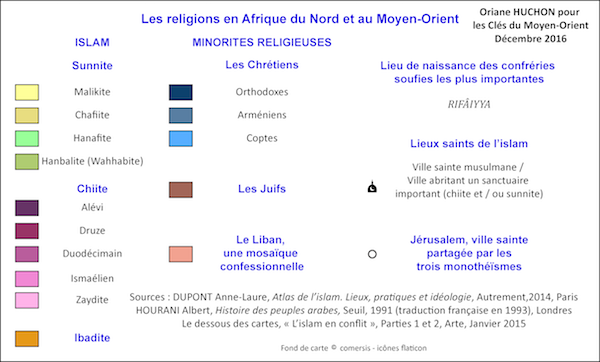
Dans les pays du Maghreb et du Moyen-Orient à l’exception d’Israël, les musulmans représentent la grande majorité de la population nationale, toutes confessions de l’islam comprises. En 2013, on estimait ainsi le nombre de musulmans au Maghreb et au Moyen-Orient, par pays :
Pays Population totale (en millions) % de musulmans dans la population Algérie 39 99% Arabie saoudite 27 100% (dont chiites entre 10 et 15%) Bahreïn 1,3 70% (chrétiens 14%, hindouisme 10%, bouddhisme 2,5%, autres) Egypte 87 90% (coptes 10%) Emirats arabes unis 8,3 96% (dont chiites 16%) Irak 32,5 97% (dont chiisme 65%, sunnisme 35%) Iran 81 98% (dont chiisme 89%) Israël 8 18% (judaïsme 75%, autres 7%) Jordanie 8 92% (christianisme 6%) Koweït 4 85% (dont chiisme 30%, christianisme et hindouisme 15%) Liban 6 54% (dont 27% chiisme, 27% sunnisme ; christianisme 40.5%) Libye 6 97% Maroc 33 98,7% Oman 3,2 90% (dont ibadisme 75%) Qatar 2,2 77% (christianisme 8,5%, autres 14%) Syrie 22 98% (dont alaouite 10%, druze 3%, chiite 2% ; christianisme 5%) Territoires palestiniens 5 Cisjordanie : 75% (judaïsme 17%), Bande de Gaza : 99% Tunisie 11 99% Turquie 82 99,8% (dont alévis 20%) Yémen 26 100% (dont zaydisme entre 25 et 40%)
Source : Revue Moyen-Orient, “Bilan géostratégique 2014”, Juillet-Septembre 2014, Paris.
L’islam ne se résume pas aux deux grands courants connus, le sunnisme et le chiisme. Ces confessions connaissent des divergences de croyances en leur sein. Le sunnisme, courant majoritaire, se divise en plusieurs écoles juridiques interprétant de diverses façons le Coran et la sunna (ou tradition, comportement du Prophète) enregistrée dans les hadiths.
Le chiisme est né de la « grande discorde » du premier siècle islamique, liée à la succession à Mahomet au titre de calife. Les trois groupes chiites existants toujours aujourd’hui (zaydite, duodécimain et ismaélien) sont issus des allégeances aux différents imams ayant succédé à Ali.
Un troisième courant nommé kharidjisme est également né au moment de la « grande discorde ». Si les kharidjites ont aujourd’hui disparu, les ibadites en sont leurs héritiers (bien que certains d’entre eux s’en défendent). Ils subsistent à Oman, à Djerba en Tunisie, en Libye à Zuwarâ et Djebel Nafusa, en Algérie à Mzâb et en Tanzanie à Zanzibar.
Enfin, de multiples confréries soufies se sont développées dans toute la région. Le soufisme est le penchant mystique de l’islam, souvent méconnu en France. Les soufis cherchent l’accès direct à la divinité d’Allah à travers des pratiques particulières dont le dhikr (répétition du nom de Dieu), la musique et la danse parfois, et la méditation. Ils s’appuient sur une théorie des hommes et du divin développée par les théologiens soufis au cours des siècles. Les confréries soufies sont nombreuses, et constituent toujours une réelle influence dans certains pays, notamment en Egypte.
Cette richesse cultuelle s’exprime par la présence de nombreux lieux saints et sanctuaires musulmans, chrétiens et juifs. Au-delà des villes saintes de Jérusalem, de Médine et de La Mecque, diverses villes attirent chaque année des milliers de pèlerins. Les sunnites les plus rigoristes interdisent le culte des saints. La mosquée n’est pas sacralisée comme l’est l’église. Les chiites toutefois célèbrent de nombreux saints, et la plupart des sunnites ressentent le besoin de « localiser le sacré, de l’inscrire dans l’espace, au travers de rites », selon les propos de Dominique Logna-Prat et de Gilles Veinstein, qui poursuivent : « Il existe ainsi des lieux [de culte des saints], généralement des sépultures, dotées de mausolées, et, le cas échéant, d’un complexe de bâtiments, dont des mosquées, que sanctifie la présence des restes d’un saint et à travers lesquels se diffuse sa baraka » (6) (Influence bénéfique qu’exercent certains personnages révérés de l’islam, ou certains objets sacrés, Larousse). Ces lieux saints et sanctuaires constituent des éléments centraux de la vie du musulman et les plus importants d’entre eux nécessitent d’apparaître sur une carte générale des religions de l’Afrique du Nord et du Moyen-Orient, puisqu’ils génèrent d’importants flux de population.
Lire sur Les clés du Moyen-Orient :
Notes :
(1) DUPONT Anne-Laure, Atlas de l’islam. Lieux, pratiques et idéologie, Autrement, 2014, Paris.
(2) Ibid.
(3) Revue Moyen-Orient n°23, “Bilan géostratégique 2014”, Juillet-Septembre 2014, Paris
(4) http://www.lemonde.fr/societe/article/2012/12/18/les-chretiens-sont-le-premier-groupe-religieux-au-monde_1807767_3224.html#VTY0lHpcA3iuy91U.99
(5) LORIEUX Claude, Chrétiens d’Orient en terres d’Islam, Perrin, 2001, Paris.
(6) « Lieux de culte, lieux saints dans le judaïsme, le christianisme et l’islam : Présentation ».
Bibliographie :
 DUPONT Anne-Laure, Atlas de l’islam. Lieux, pratiques et idéologie, Autrement, 2014, Paris.
DUPONT Anne-Laure, Atlas de l’islam. Lieux, pratiques et idéologie, Autrement, 2014, Paris.
 HOURANI Albert, Histoire des peuples arabes, Seuil, 1991 (traduction française en 1993), Londres.
HOURANI Albert, Histoire des peuples arabes, Seuil, 1991 (traduction française en 1993), Londres.
 HANIF, N, Biographical Encyclopaedia of Sufis : Central Asia and Middle East, Sarup & Sons, 2002.
HANIF, N, Biographical Encyclopaedia of Sufis : Central Asia and Middle East, Sarup & Sons, 2002.
 SELLIER André, SELLIER Jean, Atlas des peuples d’orient. Moyen-Orient, Caucase, Asie centrale, La Découverte, 2002, Paris.
SELLIER André, SELLIER Jean, Atlas des peuples d’orient. Moyen-Orient, Caucase, Asie centrale, La Découverte, 2002, Paris.
 Revue Moyen-Orient n°23, “Bilan géostratégique 2014”, Juillet-Septembre 2014, Paris.
Revue Moyen-Orient n°23, “Bilan géostratégique 2014”, Juillet-Septembre 2014, Paris.
 BALANCHE Fabrice, Atlas du Proche-Orient arabe, PUPS/RFI, 2012.
BALANCHE Fabrice, Atlas du Proche-Orient arabe, PUPS/RFI, 2012.
 LORIEUX Claude, Chrétiens d’Orient en terres d’Islam, Perrin, 2001, Paris.
Sitographie :
LORIEUX Claude, Chrétiens d’Orient en terres d’Islam, Perrin, 2001, Paris.
Sitographie :
 Le dessous des cartes, « L’islam en conflit », Parties 1 et 2, Arte, Janvier 2015.
Le dessous des cartes, « L’islam en conflit », Parties 1 et 2, Arte, Janvier 2015.
 Encyclopédie Larousse en ligne
Encyclopédie Larousse en ligne
 Encyclopedia Universalis
Encyclopedia Universalis
 http://www.lemondedesreligions.fr/actualite/les-ahmadis-musulmans-malgre-les-autres-05-02-2015-4492_118.php
http://www.lemondedesreligions.fr/actualite/les-ahmadis-musulmans-malgre-les-autres-05-02-2015-4492_118.php
 http://www.lemonde.fr/societe/article/2012/12/18/les-chretiens-sont-le-premier-groupe-religieux-au-monde_1807767_3224.html#VTY0lHpcA3iuy91U.99
http://www.lemonde.fr/societe/article/2012/12/18/les-chretiens-sont-le-premier-groupe-religieux-au-monde_1807767_3224.html#VTY0lHpcA3iuy91U.99
- L’acheminement des hydrocarbures du Moyen-Orient. Première partie : le gazoduc Qatar-Turquie et le « Islamic Pipeline » - 23/12/16
- De nouvelles salles accessibles au public au musée national de Beyrouth - 16/12/16
- Comment l’histoire explique l’actualité d’Alep. Partie 3. La destruction du patrimoine culturel de la ville et des monuments dans le conflit en Syrie depuis 2011 : zone ouest et zone est, un patrimoine contrasté - 17/11/16
Plusieurs articles sur les différents courants de l’islam sont déjà parus sur Les clés du Moyen-Orient. Celui-ci a pour objectif de présenter une cartographie de l’implantation des religions au Moyen-Orient et en Afrique du Nord. Les courants principaux y sont représentés, ainsi que les principaux lieux saints (sunnites et chiites), les lieux de naissance des principaux ordres soufis, et les minorités religieuses.
Le Moyen-Orient et l’Afrique du Nord sont les terres d’expansion de l’islam aux VIIe et VIIIe siècles de notre ère. Il ne faudrait pourtant pas considérer ces vastes territoires comme un monde unifié religieusement. Les religions antérieures à l’islam, le christianisme sous ses diverses formes (maronite, orthodoxe, copte, catholique…) et le judaïsme, demeurent au sud et à l’est de la Méditerranée et disposent d’un statut spécial dans le droit musulman, le statut de dhimmi. Jusqu’à la chute de l’Empire ottoman, le statut de dhimmi était communément appliqué dans les diverses communautés musulmanes.
Les musulmans sont de nos jours environ un milliard et demi sur la planète, soit 23% de la population mondiale. Ils forment le groupe religieux le plus important au monde après le christianisme. Les sunnites (toutes écoles confondues), représentent 87,4% de la population musulmane ; les chiites duodécimains 8,4 %, les autres mouvances chiites 3,5% et les ibadites 0,7% (1). La majorité de ces musulmans se trouve désormais en Asie, avec entre 700 et 800 millions de pratiquants, principalement en Indonésie (premier pays musulman du monde), en Afghanistan, en Inde, au Pakistan, au Bangladesh et en Chine (2). Au Moyen-Orient (Turquie, Egypte et Iran compris), ils seraient entre 350 et 400 millions ; alors qu’au Maghreb ils seraient un peu moins de 90 millions.
A titre comparatif, les chrétiens représentent 32% de la population mondiale et sont 2,2 milliards sur Terre. Les hindous sont 1 milliard, les bouddhistes 500 millions et les juifs 14 millions (4). Les juifs ont globalement fui les terres d’islam depuis la création d’Israël, et 25 % de la population juive globale vit actuellement en Israël. Les chrétiens d’Orient sont entre 10 et 16 millions au début du XXIe siècle (5).
Dans les pays du Maghreb et du Moyen-Orient à l’exception d’Israël, les musulmans représentent la grande majorité de la population nationale, toutes confessions de l’islam comprises. En 2013, on estimait ainsi le nombre de musulmans au Maghreb et au Moyen-Orient, par pays :
| Pays | Population totale (en millions) | % de musulmans dans la population |
|---|---|---|
| Algérie | 39 | 99% |
| Arabie saoudite | 27 | 100% (dont chiites entre 10 et 15%) |
| Bahreïn | 1,3 | 70% (chrétiens 14%, hindouisme 10%, bouddhisme 2,5%, autres) |
| Egypte | 87 | 90% (coptes 10%) |
| Emirats arabes unis | 8,3 | 96% (dont chiites 16%) |
| Irak | 32,5 | 97% (dont chiisme 65%, sunnisme 35%) |
| Iran | 81 | 98% (dont chiisme 89%) |
| Israël | 8 | 18% (judaïsme 75%, autres 7%) |
| Jordanie | 8 | 92% (christianisme 6%) |
| Koweït | 4 | 85% (dont chiisme 30%, christianisme et hindouisme 15%) |
| Liban | 6 | 54% (dont 27% chiisme, 27% sunnisme ; christianisme 40.5%) |
| Libye | 6 | 97% |
| Maroc | 33 | 98,7% |
| Oman | 3,2 | 90% (dont ibadisme 75%) |
| Qatar | 2,2 | 77% (christianisme 8,5%, autres 14%) |
| Syrie | 22 | 98% (dont alaouite 10%, druze 3%, chiite 2% ; christianisme 5%) |
| Territoires palestiniens | 5 | Cisjordanie : 75% (judaïsme 17%), Bande de Gaza : 99% |
| Tunisie | 11 | 99% |
| Turquie | 82 | 99,8% (dont alévis 20%) |
| Yémen | 26 | 100% (dont zaydisme entre 25 et 40%) |
Source : Revue Moyen-Orient, “Bilan géostratégique 2014”, Juillet-Septembre 2014, Paris.
L’islam ne se résume pas aux deux grands courants connus, le sunnisme et le chiisme. Ces confessions connaissent des divergences de croyances en leur sein. Le sunnisme, courant majoritaire, se divise en plusieurs écoles juridiques interprétant de diverses façons le Coran et la sunna (ou tradition, comportement du Prophète) enregistrée dans les hadiths.
Le chiisme est né de la « grande discorde » du premier siècle islamique, liée à la succession à Mahomet au titre de calife. Les trois groupes chiites existants toujours aujourd’hui (zaydite, duodécimain et ismaélien) sont issus des allégeances aux différents imams ayant succédé à Ali.
Le chiisme est né de la « grande discorde » du premier siècle islamique, liée à la succession à Mahomet au titre de calife. Les trois groupes chiites existants toujours aujourd’hui (zaydite, duodécimain et ismaélien) sont issus des allégeances aux différents imams ayant succédé à Ali.
Un troisième courant nommé kharidjisme est également né au moment de la « grande discorde ». Si les kharidjites ont aujourd’hui disparu, les ibadites en sont leurs héritiers (bien que certains d’entre eux s’en défendent). Ils subsistent à Oman, à Djerba en Tunisie, en Libye à Zuwarâ et Djebel Nafusa, en Algérie à Mzâb et en Tanzanie à Zanzibar.
Enfin, de multiples confréries soufies se sont développées dans toute la région. Le soufisme est le penchant mystique de l’islam, souvent méconnu en France. Les soufis cherchent l’accès direct à la divinité d’Allah à travers des pratiques particulières dont le dhikr (répétition du nom de Dieu), la musique et la danse parfois, et la méditation. Ils s’appuient sur une théorie des hommes et du divin développée par les théologiens soufis au cours des siècles. Les confréries soufies sont nombreuses, et constituent toujours une réelle influence dans certains pays, notamment en Egypte.
Cette richesse cultuelle s’exprime par la présence de nombreux lieux saints et sanctuaires musulmans, chrétiens et juifs. Au-delà des villes saintes de Jérusalem, de Médine et de La Mecque, diverses villes attirent chaque année des milliers de pèlerins. Les sunnites les plus rigoristes interdisent le culte des saints. La mosquée n’est pas sacralisée comme l’est l’église. Les chiites toutefois célèbrent de nombreux saints, et la plupart des sunnites ressentent le besoin de « localiser le sacré, de l’inscrire dans l’espace, au travers de rites », selon les propos de Dominique Logna-Prat et de Gilles Veinstein, qui poursuivent : « Il existe ainsi des lieux [de culte des saints], généralement des sépultures, dotées de mausolées, et, le cas échéant, d’un complexe de bâtiments, dont des mosquées, que sanctifie la présence des restes d’un saint et à travers lesquels se diffuse sa baraka » (6) (Influence bénéfique qu’exercent certains personnages révérés de l’islam, ou certains objets sacrés, Larousse). Ces lieux saints et sanctuaires constituent des éléments centraux de la vie du musulman et les plus importants d’entre eux nécessitent d’apparaître sur une carte générale des religions de l’Afrique du Nord et du Moyen-Orient, puisqu’ils génèrent d’importants flux de population.
Lire sur Les clés du Moyen-Orient :
Notes :
(1) DUPONT Anne-Laure, Atlas de l’islam. Lieux, pratiques et idéologie, Autrement, 2014, Paris.
(2) Ibid.
(3) Revue Moyen-Orient n°23, “Bilan géostratégique 2014”, Juillet-Septembre 2014, Paris
(4) http://www.lemonde.fr/societe/article/2012/12/18/les-chretiens-sont-le-premier-groupe-religieux-au-monde_1807767_3224.html#VTY0lHpcA3iuy91U.99
(5) LORIEUX Claude, Chrétiens d’Orient en terres d’Islam, Perrin, 2001, Paris.
(6) « Lieux de culte, lieux saints dans le judaïsme, le christianisme et l’islam : Présentation ».
(2) Ibid.
(3) Revue Moyen-Orient n°23, “Bilan géostratégique 2014”, Juillet-Septembre 2014, Paris
(4) http://www.lemonde.fr/societe/article/2012/12/18/les-chretiens-sont-le-premier-groupe-religieux-au-monde_1807767_3224.html#VTY0lHpcA3iuy91U.99
(5) LORIEUX Claude, Chrétiens d’Orient en terres d’Islam, Perrin, 2001, Paris.
(6) « Lieux de culte, lieux saints dans le judaïsme, le christianisme et l’islam : Présentation ».
Bibliographie :
Sitographie :
==========
CARTOGRAPHIE DES RELIGIONS (2) – LE PROCHE-ORIENT
ARTICLE PUBLIÉ LE 19/12/2016
Par Oriane Huchon
Comment se présente l’implantation des communautés religieuses majoritaires et des minorités confessionnelles sur un territoire ? Cette question est particulièrement importante pour le Proche-Orient, qui a toujours été un lieu de cohabitation entre de nombreuses confessions.
La cartographie des religions n’est jamais aisée car elle se fonde sur des estimations. Dans de nombreux pays, les recensements par confession religieuse n’existent pas. Par exemple au Liban, Etat multiconfessionnel par excellence, le dernier recensement date des années 1930, sous le mandat français, et le mot même de recensement est devenu presque tabou (1). Il s’agit donc pour le géographe ou l’historien d’établir des estimations les plus justes possibles entre les chiffres avancés par les communautés religieuses, souvent exagérés ou minimisés selon leur intérêt du moment, et les chiffres officiels quand ils existent. D’ailleurs, les sources n’avancent pas toutes les mêmes statistiques.
Le tableau suivant rend compte de la diversité religieuse du Proche-Orient :
| Pays | Population totale (en millions) | % de musulmans dans la population |
|---|---|---|
| Irak | 32,5 | 97% (dont chiisme 65%, sunnisme 35%) |
| Israël | 8 | 18% (judaïsme 75%, autres 7%) |
| Jordanie | 8 | 92% (christianisme 6%) |
| Syrie | 22 | 98% (dont alaouite 10%, druze 3%, chiite 2% ; christianisme 5%) |
| Territoires palestiniens | 5 | Cisjordanie : 75% (judaïsme 17%), Bande de Gaza : 99% |
Source : Revue Moyen-Orient, “Bilan géostratégique 2014”, Juillet-Septembre 2014, Paris
Les musulmans
Les musulmans sunnites sont majoritaires au Proche-Orient. Dans la Bande de Gaza par exemple, ils représentent plus de 99% de la population. Mais ils ne sont pas majoritaires dans tous les Etats : 27% au Liban et 18% en Israël.
Le chiisme est très implanté dans certains Etats du Proche-Orient. Une forte communauté chiite est ainsi présente en Irak (65% de la population), au Koweït (30%) et au Liban (27%). A titre indicatif, en Iran, le chiisme est religion d’Etat et est pratiqué par 80 à 90% de la population. L’Iran sera traitée dans un prochain article des Clés du Moyen-Orient. D’importants lieux saints chiites se trouvent en Irak (Samarra, Khadimeyn Kerbala, Nadjaf) et en Syrie (Damas).
Au Proche-Orient subsistent d’anciennes sectes attachées à l’islam : les Druzes (2), les Alaouites (3) ou les Yézidis (4). Il y aurait 900 000 Druzes répartis entre le Liban, la Syrie et la Galilée ; environ 2 300 000 Alaouites en Syrie (soit 10% de la population syrienne) ; 700 000 Yézidis entre le nord de la Turquie, la Syrie et l’Irak.
Il est parfois difficile de distinguer la frontière entre communauté religieuse et peuple à part entière, comme par exemple dans le cas des Druzes et des Yézidis qui ont perpétué des traditions culturelles et cultuelles propres et vivent relativement reclus sur eux-mêmes.
Enfin, il faut noter la présence de 30 à 40 millions de Kurdes répartis entre l’est de la Turquie et le nord de la Syrie, de l’Irak et de l’Iran. Les Kurdes, s’ils ne sont pas liés par une unité religieuse, partagent le statut de minorité et jouent actuellement un rôle actif de protection des Yézidis et des chrétiens face à l’organisation de l’Etat islamique (OEI).
Le chiisme est très implanté dans certains Etats du Proche-Orient. Une forte communauté chiite est ainsi présente en Irak (65% de la population), au Koweït (30%) et au Liban (27%). A titre indicatif, en Iran, le chiisme est religion d’Etat et est pratiqué par 80 à 90% de la population. L’Iran sera traitée dans un prochain article des Clés du Moyen-Orient. D’importants lieux saints chiites se trouvent en Irak (Samarra, Khadimeyn Kerbala, Nadjaf) et en Syrie (Damas).
Au Proche-Orient subsistent d’anciennes sectes attachées à l’islam : les Druzes (2), les Alaouites (3) ou les Yézidis (4). Il y aurait 900 000 Druzes répartis entre le Liban, la Syrie et la Galilée ; environ 2 300 000 Alaouites en Syrie (soit 10% de la population syrienne) ; 700 000 Yézidis entre le nord de la Turquie, la Syrie et l’Irak.
Il est parfois difficile de distinguer la frontière entre communauté religieuse et peuple à part entière, comme par exemple dans le cas des Druzes et des Yézidis qui ont perpétué des traditions culturelles et cultuelles propres et vivent relativement reclus sur eux-mêmes.
Enfin, il faut noter la présence de 30 à 40 millions de Kurdes répartis entre l’est de la Turquie et le nord de la Syrie, de l’Irak et de l’Iran. Les Kurdes, s’ils ne sont pas liés par une unité religieuse, partagent le statut de minorité et jouent actuellement un rôle actif de protection des Yézidis et des chrétiens face à l’organisation de l’Etat islamique (OEI).
Les juifs
Depuis la création de l’Etat d’Israël en 1948, les communautés juives ancestrales en pays musulmans ont presque toutes disparues. Les juifs vivent désormais majoritairement en Israël, où ils représentent 75% de la population, ou dans les pays occidentaux.
Les chrétiens
Selon Claude Lorieux (5), les chrétiens en terres musulmanes étaient en 2000 entre 10 000 000 et 16 000 000, dont :
Irak : entre 600 000 et 1 000 000
Syrie : entre 950 000 et 1 300 000
Liban : entre 1 300 000 et 1 500 000
Israël : entre 105 000 et 120 000
Territoires palestiniens : 60 000 à 80 000
Jordanie : 140 000 à 160 000
(A titre indicatif, Iran : 120 000 à 130 000 ; Turquie : entre 100 000 et 130 000)
Syrie : entre 950 000 et 1 300 000
Liban : entre 1 300 000 et 1 500 000
Israël : entre 105 000 et 120 000
Territoires palestiniens : 60 000 à 80 000
Jordanie : 140 000 à 160 000
(A titre indicatif, Iran : 120 000 à 130 000 ; Turquie : entre 100 000 et 130 000)
A l’exception de certaines zones au Liban, à l’instar du Mont Liban qui est majoritairement peuplé de maronites, les chrétiens sont minoritaires au Proche-Orient. Il existe une grande diversité d’Eglises différentes : géorgiens, maronites, catholiques, orthodoxes, assyriens, chaldéens, etc. Et autant de traditions culturelles et cultuelles différentes. Les chrétiens d’Orient n’ont pas le même statut dans tous les pays, et connaissent aujourd’hui des persécutions.
La question des tensions interconfessionnelles n’est pas nouvelle. Sous l’Empire ottoman déjà, les minorités étaient persécutées, qu’il s’agisse des Yézidis, des Kurdes, des Arméniens… Un changement s’est toutefois opéré ces dernières années. Depuis les années 1990 et particulièrement depuis l’émergence de l’OEI, les persécutions de plus en plus violentes contre les chrétiens d’Orient, particulièrement en Irak et en Syrie, poussent ceux-ci à l’exil (6). Une partie de ces chrétiens demeure cependant au Proche-Orient, et s’est réfugiée dans le Kurdistan autonome irakien, en Jordanie, en Turquie ou au Liban. Mais ils sont de plus en plus nombreux à quitter la région pour se rendre dans les pays occidentaux. Ainsi, si le berceau de la chrétienté assyro-chaldéenne se trouve dans le nord de l’Irak dans la région de Mossoul, peu de chrétiens sont restés dans cette région, forcés à l’exil de masse depuis 2014. L’OEI est également responsable du massacre et de l’exil des Yézidis (7). Reste à savoir si ces communautés exilées reviendront un jour. Il est possible que, dans quelques années, la carte des religions au Proche-Orient soit sensiblement modifiée, notamment en Irak et en Syrie.
La question des tensions interconfessionnelles n’est pas nouvelle. Sous l’Empire ottoman déjà, les minorités étaient persécutées, qu’il s’agisse des Yézidis, des Kurdes, des Arméniens… Un changement s’est toutefois opéré ces dernières années. Depuis les années 1990 et particulièrement depuis l’émergence de l’OEI, les persécutions de plus en plus violentes contre les chrétiens d’Orient, particulièrement en Irak et en Syrie, poussent ceux-ci à l’exil (6). Une partie de ces chrétiens demeure cependant au Proche-Orient, et s’est réfugiée dans le Kurdistan autonome irakien, en Jordanie, en Turquie ou au Liban. Mais ils sont de plus en plus nombreux à quitter la région pour se rendre dans les pays occidentaux. Ainsi, si le berceau de la chrétienté assyro-chaldéenne se trouve dans le nord de l’Irak dans la région de Mossoul, peu de chrétiens sont restés dans cette région, forcés à l’exil de masse depuis 2014. L’OEI est également responsable du massacre et de l’exil des Yézidis (7). Reste à savoir si ces communautés exilées reviendront un jour. Il est possible que, dans quelques années, la carte des religions au Proche-Orient soit sensiblement modifiée, notamment en Irak et en Syrie.
Bibliographie :
BALANCHE Fabrice, Atlas du Proche-Orient Arabe, PUPS/RFI, 2012.
Notes :
(1) http://www.lesclesdumoyenorient.com/Le-Liban-geographie-d-un-Etat.html
(2) http://www.lesclesdumoyenorient.com/Druzes.html
(3) http://www.lesclesdumoyenorient.com/Les-Alaouites-et-la-crise-politique-en-Syrie
(4) http://www.lesclesdumoyenorient.com/En-lien-avec-l-actualite-en-Irak-1705.html
(5) Claude Lorieux, Chrétiens d’Orient en terres d’Islam, Perrin, 2001.
(6) http://www.lesclesdumoyenorient.com/Le-lent-declin-des-communautes.html
(7) http://www.lesclesdumoyenorient.com/Les-Yezidis-des-monts-Sinjar-et-la-nouvelle-question-d-Orient-Retour-sur-le.html
(1) http://www.lesclesdumoyenorient.com/Le-Liban-geographie-d-un-Etat.html
(2) http://www.lesclesdumoyenorient.com/Druzes.html
(3) http://www.lesclesdumoyenorient.com/Les-Alaouites-et-la-crise-politique-en-Syrie
(4) http://www.lesclesdumoyenorient.com/En-lien-avec-l-actualite-en-Irak-1705.html
(5) Claude Lorieux, Chrétiens d’Orient en terres d’Islam, Perrin, 2001.
(6) http://www.lesclesdumoyenorient.com/Le-lent-declin-des-communautes.html
(7) http://www.lesclesdumoyenorient.com/Les-Yezidis-des-monts-Sinjar-et-la-nouvelle-question-d-Orient-Retour-sur-le.html
- ===================
- L’acheminement des hydrocarbures du Moyen-Orient. Deuxième partie : les autres pipelines de la région - 30/12/16
- L’acheminement des hydrocarbures du Moyen-Orient. Première partie : le gazoduc Qatar-Turquie et le « Islamic Pipeline » - 23/12/16
- L’Arabie saoudite et les Etats-Unis : une relation sur le déclin. Deuxième Partie : relations militaires, politiques et stratégiques entre les deux pays - 02/11/16
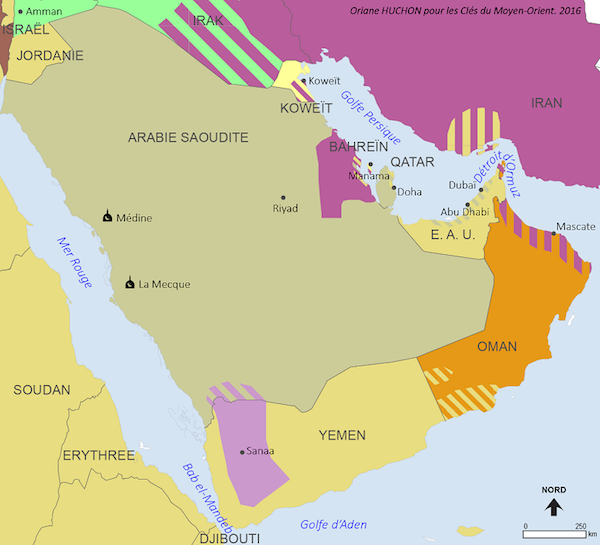
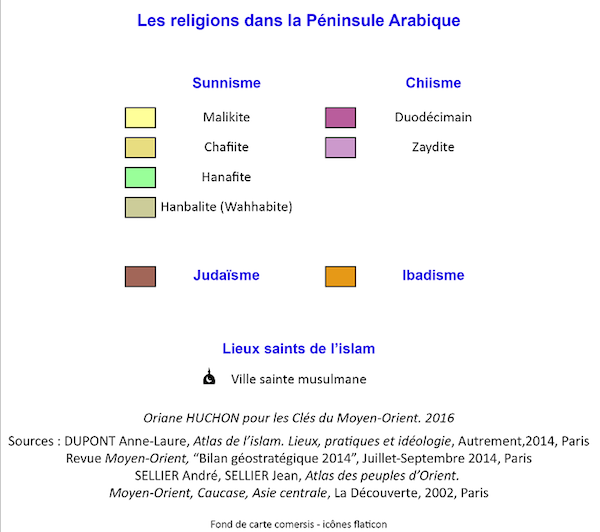
- L’acheminement des hydrocarbures du Moyen-Orient. Deuxième partie : les autres pipelines de la région - 30/12/16
- L’acheminement des hydrocarbures du Moyen-Orient. Première partie : le gazoduc Qatar-Turquie et le « Islamic Pipeline » - 23/12/16
- Relations turbulentes entre la Russie et l’Iran au Moyen-Orient. Deuxième partie : la guerre civile en Syrie et ses prolongements - 16/11/16
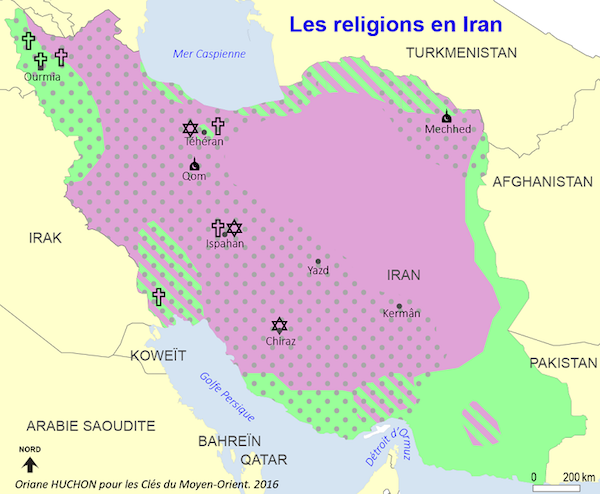
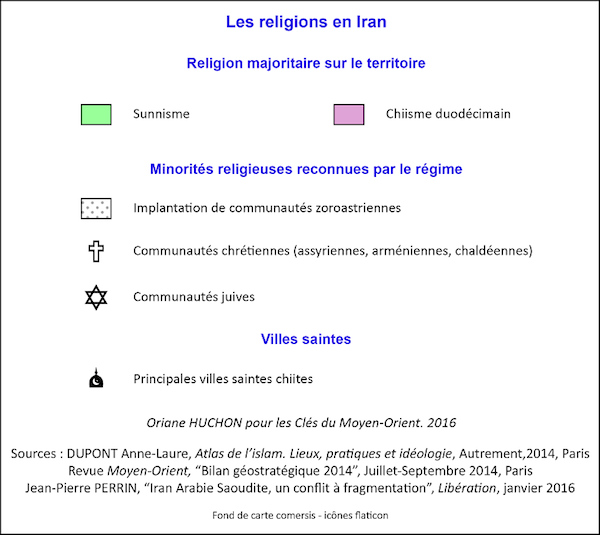
CARTOGRAPHIE DES RELIGIONS (3) – LA PÉNINSULE ARABIQUE
Par Oriane Huchon
ARTICLE PUBLIÉ LE 28/12/2016
Dernières actualités
La péninsule arabique est le lieu de naissance de l’islam. Elle constitue un espace où la diversité religieuse demeure et où s’exprime un large éventail de rites musulmans différents. C’est en Arabie saoudite que les villes saintes se situent. Médine, la ville du Prophète Mahomet, et La Mecque, sont au centre du monde musulman. Le pèlerinage annuel à La Mecque, ou Hajj, est obligatoire dans la vie de tout musulman capable de l’effectuer puisqu’il est le cinquième pilier de l’islam.Diversité confessionnelle dans la péninsule arabique
De multiples courants de l’islam sont représentés dans la péninsule arabique.Au centre de la péninsule, l’Arabie saoudite est intrinsèquement wahhabite. Le wahhabisme est le courant sunnite le plus rigoriste, et est issu de l’école juridique hanbalite. La dynastie des Saoud s’est alliée au prédicateur Muhammad bin Abd al-Wahhab dès le XVIIIe siècle (1745) dans le but de constituer un royaume musulman unifié et purifié de toute dérive (culte des saints, musique rituelle…). La puissance de l’Etat saoudien, issue de sa souveraineté sur les lieux saints et de ses ressources pétrolières, a contribué à diffuser et à légitimer le wahhabisme, qui était auparavant craint car trop sévère et rigoriste. Il existe toutefois une importante minorité chiite (duodécimains) sur les rivages du Golfe persique.Le Golfe Persique est le théâtre de nombreuses expressions de la foi religieuse. Au Koweït, les sunnites malikites côtoient les chiites duodécimains, eux-mêmes majoritaires en Iran, à l’est de l’Irak, à Bahreïn (dont la dynastie régnante est sunnite), et à l’est de l’Arabie saoudite. Au Qatar, seul Etat à partager le wahhabisme avec l’Arabie saoudite, d’autres rites sunnites sont présents, notamment chafiite. Oman quant à lui est le bastion historique de l’ibadisme, pratiqué par 75% de la population, courant religieux issu du khâridjisme et distinct du sunnisme et du chiisme. L’ibadisme y côtoie une forte communauté chiite, et une petite communauté sunnite.Dans tous ces Etats de la péninsule arabique et du Golfe persique, il faut également tenir compte d’importantes minorités religieuses liées aux immigrés venus trouver du travail dans les pétromonarchies. Ces populations asiatiques (pakistanaises, indonésiennes, indiennes, sri-lankaises, bangladaises, philippines…) sont souvent hindouistes et parfois bouddhistes ou chrétiennes. Ainsi, en 2014 à Bahreïn, la population étrangère représentait 54% de la population totale, le christianisme était pratiqué par 14% de la population, l’hindouisme par 10% et le bouddhisme par 2,5% de la population totale.
Enfin, le Yémen est partagé entre des sunnites chafiites (entre 60 et 75% de la population) et des chiites zaydites (entre 25 et 40% de la population). Cette division est à l’origine, parmi de multiples autres facteurs, des conflits qui ont cours actuellement au Yémen.Le pèlerinage à La Mecque
L’Arabie saoudite est la gardienne des lieux saints. Si ce rôle est aujourd’hui contesté, notamment par l’Iran chiite, il n’en demeure pas moins que les Saoud sont les garants du bon déroulement du pèlerinage et de son organisation. Le pèlerinage à La Mecque a lieu une fois par an dans le calendrier lunaire et est à l’origine d’importants flux de populations. Historiquement, le pèlerinage durait plusieurs mois, voire plusieurs années selon la provenance du pèlerin, et était périlleux. Aujourd’hui, les pèlerins arrivent par avion à Djeddah, à l’aéroport international Roi-Abdelaziz. D’immenses travaux sont entrepris depuis les années 1970 par les autorités saoudiennes pour accueillir toujours plus de pèlerins. Les complexes hôteliers sont construits sur des lieux historiques, à l’instar de la maison de Khadija.Le journal Le Monde (1) a établi en 2015 un calcul des chiffres du hajj. Ainsi, selon le journal, en 2015 le hajj aurait impliqué :
 1,323 millions de pèlerins étrangers, pour un total d’environ 2 millions de pèlerins
1,323 millions de pèlerins étrangers, pour un total d’environ 2 millions de pèlerins
 5,75 milliards d’euros de revenus
5,75 milliards d’euros de revenus
Chaque année, les pèlerins sont plus nombreux. Cela demande des efforts logistiques et économiques majeurs à l’Arabie saoudite : approvisionner tous les pèlerins en eau dans une ville qui a toujours été marquée par la sècheresse, apporter assez de cailloux pour la lapidation de Satan… Les flux de populations entraînent également le transport de certaines maladies épidémiques, comme le coronavirus en 2013 et nécessitent donc un renforcement des mesures sanitaires afin d’éviter leur propagation.
Le hajj est chaque année le théâtre de bousculades meurtrières. En 2015, année la plus meurtrière de l’histoire du pèlerinage, au moins 2000 pèlerins sont morts lors de l’Aïd al-Adha (les autorités saoudiennes ont communiqué le chiffre officiel de 769 morts). Les mouvements de foule sont récurrents et expliquent les dizaines de milliers d’agents engagés par les autorités saoudiennes pour tenter de maintenir l’ordre et le bon déroulement du pèlerinage.A LIRE EGALEMENT SUR LES CLES DU MOYEN-ORIENT :Bibliographie : DUPONT Anne-Laure, Atlas de l’islam. Lieux, pratiques et idéologie, Autrement, 2014, Paris.
DUPONT Anne-Laure, Atlas de l’islam. Lieux, pratiques et idéologie, Autrement, 2014, Paris.
 Revue Moyen-Orient n°23, “Bilan géostratégique 2014”, Juillet-Septembre 2014, Paris.
Revue Moyen-Orient n°23, “Bilan géostratégique 2014”, Juillet-Septembre 2014, Paris.
 SELLIER André, SELLIER Jean, Atlas des peuples d’Orient. Moyen-Orient, Caucase, Asie centrale, La Découverte, 2002, Paris.
SELLIER André, SELLIER Jean, Atlas des peuples d’Orient. Moyen-Orient, Caucase, Asie centrale, La Découverte, 2002, Paris.
 BALANCHE Fabrice, Atlas du Proche-Orient Arabe, PUPS/RFI, 2012.
BALANCHE Fabrice, Atlas du Proche-Orient Arabe, PUPS/RFI, 2012.
 RONDOT, Pierre, L’Islam dans la péninsule Arabique In : La péninsule Arabique aujourd’hui. Tome I [en ligne]. Aix-en-Provence : Institut de recherches et d’études sur le monde arabe et musulman, 1982 (généré le 24 octobre 2016).=============δ' μέροςhttp://www.lesclesdumoyenorient.com/Cartographie-des-religions-4-L-Iran.html
RONDOT, Pierre, L’Islam dans la péninsule Arabique In : La péninsule Arabique aujourd’hui. Tome I [en ligne]. Aix-en-Provence : Institut de recherches et d’études sur le monde arabe et musulman, 1982 (généré le 24 octobre 2016).=============δ' μέροςhttp://www.lesclesdumoyenorient.com/Cartographie-des-religions-4-L-Iran.htmlCARTOGRAPHIE DES RELIGIONS (4) – L’IRAN
Par Oriane Huchon
ARTICLE PUBLIÉ LE 04/01/2017
Dernières actualités
L’Iran est une théocratie de 81 millions d’habitants. L’islam représente environ 98% de la population, mais il existe de nombreuses minorités religieuses. Contrairement à ce que l’on pourrait penser, l’instauration de la République islamique d’Iran en 1979, qui place la shari’a au-dessus de la constitution, n’a pas modifié en profondeur la place de ces minorités dans la société.
Peuples et religions de Perse et d’Iran
La Perse a été très tôt dans l’histoire un carrefour entre les peuples. Ce lieu de mixité a donné naissance à un foisonnement intellectuel, artistique et religieux majeur tout au long des siècles. A tel point que l’historien Richard Foltz (1) minore le rôle du Proche-Orient au profit de l’Iran dans la naissance des religions actuelles.
Il faut faire la distinction entre minorité ethnique, minorité linguistique et minorité religieuse. En Iran cohabitent sept groupes linguistiques, une quinzaine d’ethnies et six religions différents. Ces groupes sont pour la plupart assez larges, connaissent des ramifications en leur sein et se superposent les uns aux autres, ce qui ajoute à la complexité du paysage ethno-linguistico-religieux national. Par exemple, les Arabes sont essentiellement musulmans sunnites et parlent l’arabe ; mais les baha’is sont Persans et parlent le farsi. Vis-à-vis de ces minorités, tant la dynastie Pahlavi (1925-1979) que l’actuelle République islamique ont adopté des politiques d’assimilation et d’intégration à une identité iranienne, ou « iranité », commune.Le chiisme duodécimain, religion officielle et majoritaire
Depuis l’instauration sous la contrainte du chiisme duodécimain (ou ja’fari) comme religion officielle de l’Etat iranien par Ismaïl Ier en 1501, le chiisme s’est largement répandu au sein de la nation iranienne. Représentant aujourd’hui entre 80 et 90% de la population, selon les sources, l’Iran est toujours le seul Etat à être officiellement chiite. A titre de comparaison, le chiisme représente 10 à 15% des musulmans dans le monde.Le chiisme duodécimain est parfois surnommé par les sunnites le « chiisme iranien », ce que récusent les Iraniens. Cette dénomination est le résultat de plusieurs siècles de particularismes et d’indépendance de l’Iran vis-à-vis de l’islamisation et des mondes arabes et ottomans voisins (2). D’une part parce que la langue arabe ne s’est pas imposée en parallèle de l’islam au moment de la conquête (VIIe-VIIIe siècles ap. J.C.). Contrairement aux langues parlées dans les autres régions en cours d’islamisation, le persan a su résister face à l’arabe et demeurer la langue du quotidien, de la politique et de la poésie, tandis que l’arabe n’était adopté que pour la religion. D’autre part parce que la dynastie Safavide a adopté le chiisme comme religion officielle en partie en opposition à l’Empire ottoman sunnite voisin, séparant définitivement l’Iran du reste du monde musulman. Mais il ne faut pas oublier pour autant qu’en 1501 peu de Perses étaient chiites, et que l’instauration du chiisme comme religion officielle relevait d’une décision politique plus que d’une réalité populaire.Des minorités religieuses ignorées ou réprimées : les sunnites et les baha’is
Les musulmans sunnites, essentiellement Kurdes, Turkmènes, Baloutches et Arabes représentent entre 9 et 15% de la population. Les sunnites sont plutôt implantés dans les zones frontalières de l’Iran et au niveau du Golfe persique, mais il existe également quelques petites communautés sunnites dans le centre-est du pays. Les sunnites sont considérés comme des citoyens de seconde zone dans la société, à l’instar des baha’is.Les baha’is représenteraient entre 100 000 et 500 000 individus en Iran et constitueraient la deuxième religion du pays après l’islam. Le baha’isme est une secte issue du chiisme au XIXe siècle sous la prédication de l’Iranien Bahá’u’lláh, qui prônait l’unité de l’humanité, une éducation universelle, l’égalité des sexes, la paix dans le monde et la création d’une langue universelle. Les croyants baha’is se convertissent à l’âge adulte après l’acceptation de la vérité religieuse prêchée par le prophète Bahá’u’lláh. Ils sont présents dans le monde entier et revendiquent plusieurs millions de fidèles. Les autorités iraniennes considèrent ce mouvement apostat et à la solde des puissances occidentales et d’Israël, puisque le centre religieux du mouvement se situe aujourd’hui à Haïfa, en Israël. Les baha’is n’ont pas le droit de travailler, d’étudier à l’université, d’inscrire leurs noms sur leurs tombes… Les baha’is d’Iran sont plutôt citadins et Persans.
Pour ces deux minorités, il n’existe pas de statistiques officielles, ce qui explique la difficulté d’évaluation de leur part dans la société iranienne.Minorités religieuses reconnues : juifs, zoroastriens et chrétiens
Les trois minorités religieuses reconnues et protégées par le régime sont les juifs, les zoroastriens et les chrétiens. La Constitution de 1979 prévoit un député pour les juifs, trois députés pour les chrétiens (un député pour les Chaldéens, un député pour les Arméniens et un député pour les Assyriens) et un député pour les zoroastriens. En revanche, la voix d’un non-musulman (ou d’une femme) au tribunal vaut la moitié de la voix d’un musulman.
La diaspora juive en Iran est ancienne, elle remonterait au VIe siècle ap. J.C. Les juifs étaient nombreux en Iran jusqu’en 1979. En 1976, on en dénombrait encore 62 000 alors que partout ailleurs au Moyen-Orient, les communautés juives avaient presque disparu en raison de la création d’Israël. Bien que la Constitution de 1979 donne un statut aux juifs et un siège au Parlement, ils ont massivement émigré vers Israël, le pouvoir les accusant de sionisme et de collusion avec Israël et les Etats-Unis.
Les zoroastriens sont les héritiers de la religion antique du mazdéisme réformée par Zoroastre entre le VIIe et le XVIIe siècle avant J.C. Ils seraient environ 20 000 demeurant en Iran et habiteraient surtout dans des petits villages des provinces du Yazd et du Kermân, vers le centre de l’Iran.
Les chrétiens se regroupent sous trois Eglises reconnues par l’Etat : arménienne, assyrienne et chaldéenne. Ils ne sont pas persécutés et ont certaines libertés, comme de produire de l’alcool. Les chrétiens arméniens sont majoritaires (entre 200 000 et 400 000 individus) et sont les plus intégrés. Ils sont installés à Ispahan et à Téhéran. Les chrétiens chaldéens seraient 8000.Lire sur Les clés du Moyen-Orient :Notes :(1) Richard FOLTZ, L’Iran, creuset des religions : de la préhistoire à la République islamique, Québec, Les Presses de l’Université Laval, 2007.
(2) Yann RICHARD, « L’Islam en Iran », Grand atlas des religions, Paris, Encyclopaedia Universalis, 1990.Sources : Ali BANUAZIZI, Myron WEINER, The State, Religion and Ethnic Politics. Afghanistan, Iran, and Pakistan, New York, Syracuse University Press, 1986.
Ali BANUAZIZI, Myron WEINER, The State, Religion and Ethnic Politics. Afghanistan, Iran, and Pakistan, New York, Syracuse University Press, 1986. Anne-Laure DUPONT, Atlas de l’islam. Lieux, pratiques et idéologie, Paris, Autrement, 2014.
Anne-Laure DUPONT, Atlas de l’islam. Lieux, pratiques et idéologie, Paris, Autrement, 2014. Richard FOLTZ, L’Iran, creuset des religions : de la préhistoire à la République islamique, Québec, Les Presses de l’Université Laval, 2007.
Richard FOLTZ, L’Iran, creuset des religions : de la préhistoire à la République islamique, Québec, Les Presses de l’Université Laval, 2007. Yann RICHARD, « L’Islam en Iran », Grand atlas des religions, Paris, Encyclopaedia Universalis, 1990.
Yann RICHARD, « L’Islam en Iran », Grand atlas des religions, Paris, Encyclopaedia Universalis, 1990. André SELLIER, Jean SELLIER, Atlas des peuples d’Orient. Moyen-Orient, Caucase, Asie centrale, Paris, La Découverte, 2002.
André SELLIER, Jean SELLIER, Atlas des peuples d’Orient. Moyen-Orient, Caucase, Asie centrale, Paris, La Découverte, 2002. Revue Moyen-Orient n°23, “Bilan géostratégique 2014”, Juillet-Septembre 2014, Paris.Sitographie :
Revue Moyen-Orient n°23, “Bilan géostratégique 2014”, Juillet-Septembre 2014, Paris.Sitographie : Dossier « Les religions d’Iran », La Croix : http://www.la-croix.com/Monde/Religions-d-Iran-2014-08-19-1193805
Dossier « Les religions d’Iran », La Croix : http://www.la-croix.com/Monde/Religions-d-Iran-2014-08-19-1193805  http://iran.blog.lemonde.fr/2010/08/10/le-bahaisme-seule-religion-officiellement-persecutee-en-iran/
http://iran.blog.lemonde.fr/2010/08/10/le-bahaisme-seule-religion-officiellement-persecutee-en-iran/ http://www.lemondedesreligions.fr/actualite/la-republique-islamique-une-theocratie-videe-de-son-caractere-religieux-14-06-2013-3160_118.php
http://www.lemondedesreligions.fr/actualite/la-republique-islamique-une-theocratie-videe-de-son-caractere-religieux-14-06-2013-3160_118.php http://www.la-croix.com/Actualite/Monde/Bien-que-musulmans-les-sunnites-d-Iran-sont-discrimines-2014-08-22-1195271Pour la carte :
http://www.la-croix.com/Actualite/Monde/Bien-que-musulmans-les-sunnites-d-Iran-sont-discrimines-2014-08-22-1195271Pour la carte :
Inscription à :
Articles (Atom)



